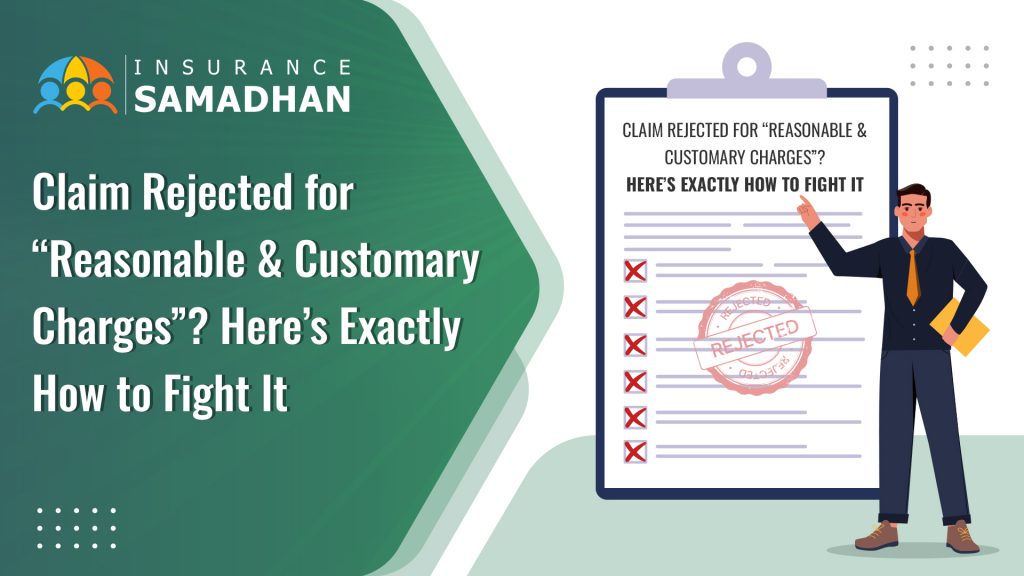“Reasonable & Customary (R&C) charges” is a clause most health policies use to cap payouts at what’s typical for a treatment in your city and at that grade of hospital. If your hospital bill exceeds that benchmark, the insurer may prune the claim or reject a portion—often without explaining the benchmark they used. In practice, this is one of the most frequently cited reasons policyholders see partial payments.
First, know your rights. IRDAI’s rules require insurers to settle a health claim within defined timelines after receiving the last required document, and to pay interest at bank rate +2% for delays. If an investigation is needed, they still must complete the process within the stipulated window. Use this leverage when you write to the insurer and the TPA.

Second, request transparency. Ask the insurer for (a) the exact R&C benchmark used, (b) the data source (city-level tariff, panel rates), and (c) the line-item comparison showing how they arrived at each deduction. Many policy wordings define R&C as the provider’s standard rate consistent with prevailing charges in the geographical area for similar services—use that language back at them.
Third, prove medical necessity and parity. Get your treating doctor’s note on why specific consumables, implants, or ICU bed class were essential. If your policy has no room-rent cap or sub-limit, call that out explicitly, because some R&C cuts are misapplied as a proxy for sub-limits.
Fourth, escalate with timelines. If your representation isn’t resolved within the IRDAI time limits (or you aren’t given a defensible benchmark), escalate via the insurer’s Grievance Redressal Officer, then Bima Bharosa/CIO, and (once available in your policy wording/process) the Internal Insurance Ombudsman step. Keep a single email thread with all annexures; it shortens review time and strengthens your case for interest on delay.
A customer receives a call or is approached at a bank branch. The pitch is attractive: “Take a zero percent loan with no processing fee — all you need to do is take this insurance policy as a formality.” Sometimes, the bait is even sweeter: “You’ll also get tax benefits and your money will grow.” Desperate for funds or lured by the thought of an interest-free loan, the customer agrees. Soon after, instead of a loan approval letter, they receive a bulky life insurance policy pack. The promised loan never comes.
Click here to register your complaint with Insurance Samadhan
Visit our website: insurancesamadhan.com
Mail us at corporate@insurancesamadhan.com
FAQ (with How-To steps)
standard policy definition: charges that match the provider’s usual rates and the prevailing charges in your geographic area for identical or similar services, considering the illness/injury. If billed amounts exceed that benchmark, insurers cap the payout.
1. Ask for proof: Request the benchmark table, source, city, hospital tier, and line-item math.
2. Submit evidence: Two–three comparable quotes + treating doctor’s justification.
3. Cite policy wording: Quote the R&C definition and your city/grade parity.
4. Enforce timelines: Remind the insurer of settlement timelines and interest at bank rate +2% on delays.
5. Escalate: GRO → Bima Bharosa/CIO (and Internal Ombudsman where applicable).
Insurers must settle within the specified period after the last document is received; if delayed, interest at bank rate +2% applies. Where investigation is required, the outer limit remains defined by regulation/micro-guidelines.
It can—R&C applies to both cashless and reimbursement. Use the same documentation strategy and insist on the insurer’s benchmark proof.
If the insurer won’t share benchmarks, applies city-mismatch tariffs, or misses timelines, bring in a specialist to draft the grievance and compute interest on delay.